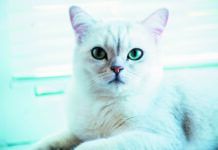Keeping your cat indoors exclusively is certainly best for her health and safety, but it can also create issues of obesity and boredom. Is there something the responsible pet owner can do to enhance indoor living? According to a study recently published in the Journal of Feline Medicine and Surgery, the answer could be as simple as a food puzzle.
The closest wild ancestor to our domestic cat is the African wildcat, who is a predator that hunts several times a day to procure small meals. When this basic instinct is removed from the lives of domestic cats — with the daily supply of kibble always at the ready — the result can sometimes be health issues or bad behavior.
Essentially, a food puzzle is an object that can hold food and release it through some effort of the cat. So instead of the regularly planned meal regimen that we supply, the food puzzle can take the place of “hunts” throughout the day, encouraging the cats to work for their food and stay mentally engaged.
Originally, food puzzles were designed for animals housed in zoos and labs. In their own veterinary and behavioral practices, the authors wrote that they have observed many benefits using food puzzles with cats including “weight loss, decreased aggression toward humans and other cats … cessation of attention-seeking behavior and resolution of litter box avoidance.”
“Food puzzles provide cats with exercise and mental stimulation,” wrote review co-author Mikel Delgado, a doctoral candidate of psychology at the University of California, Berkeley.
There are different versions of these contraptions — some stationary, others mobile — at different price points and availability. And as we already know, it’s sometimes hard to determine what new gadget will appeal to our cats. Making a homemade device is also an inexpensive option — to reuse simple household items and also to see if this sort of thing appeals to your pet.
Hint: It’s best to start out with simple puzzles, and then gradually move up to more complex ones. And if your cat doesn’t seem interested in the puzzles you offer, try using tastier morsels of food.
Some homemade ideas
Cut numerous holes in the sides of an empty water bottle. (The holes should be larger than the size of your cat’s kibble or treats.) Put treats inside the bottle, and then replace the cap. Once your cat has mastered the puzzle, you can create more difficult versions by making the holes smaller and making fewer holes overall. You can also use other items, like an empty yogurt container.
If your pet prefers wet food, you can use a muffin or cupcake tin as a simple food puzzle. Fill each cup with a tiny amount of her food, which will encourage her to walk around the tin to find all the food. — Catnip staff



